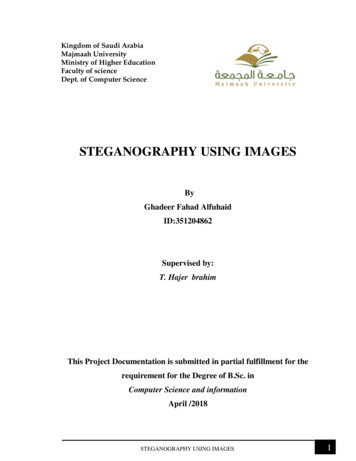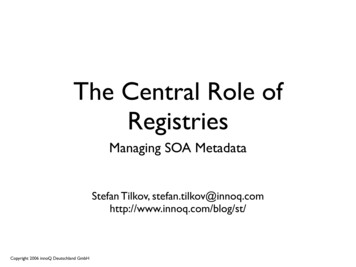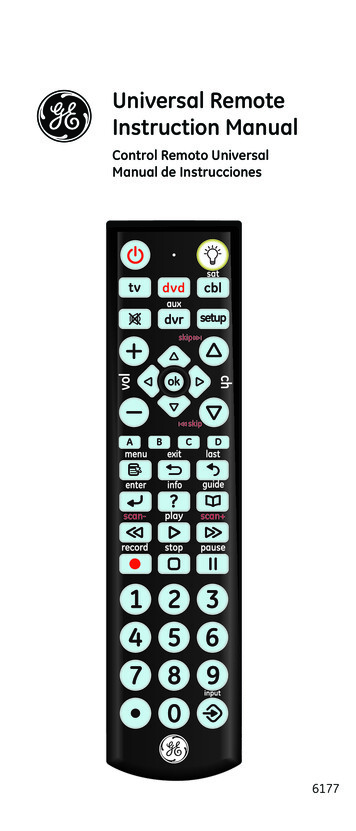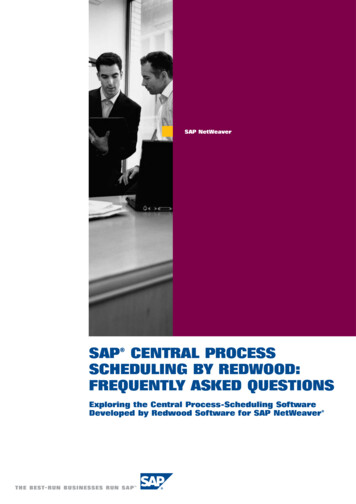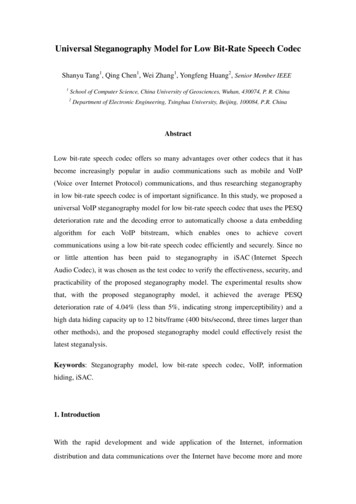
Transcription
Universal Steganography Model for Low Bit-Rate Speech CodecShanyu Tang1, Qing Chen1, Wei Zhang1, Yongfeng Huang2, Senior Member IEEE1School of Computer Science, China University of Geosciences, Wuhan, 430074, P. R. China2Department of Electronic Engineering, Tsinghua University, Beijing, 100084, P.R. ChinaAbstractLow bit-rate speech codec offers so many advantages over other codecs that it hasbecome increasingly popular in audio communications such as mobile and VoIP(Voice over Internet Protocol) communications, and thus researching steganographyin low bit-rate speech codec is of important significance. In this study, we proposed auniversal VoIP steganography model for low bit-rate speech codec that uses the PESQdeterioration rate and the decoding error to automatically choose a data embeddingalgorithm for each VoIP bitstream, which enables ones to achieve covertcommunications using a low bit-rate speech codec efficiently and securely. Since noor little attention has been paid to steganography in iSAC (Internet SpeechAudio Codec), it was chosen as the test codec to verify the effectiveness, security, andpracticability of the proposed steganography model. The experimental results showthat, with the proposed steganography model, it achieved the average PESQdeterioration rate of 4.04% (less than 5%, indicating strong imperceptibility) and ahigh data hiding capacity up to 12 bits/frame (400 bits/second, three times larger thanother methods), and the proposed steganography model could effectively resist thelatest steganalysis.Keywords: Steganography model, low bit-rate speech codec, VoIP, informationhiding, iSAC.1. IntroductionWith the rapid development and wide application of the Internet, informationdistribution and data communications over the Internet have become more and more
simple and efficient, so people are becoming increasingly concerned about thesecurity of the private information transmitted over the Internet. Cryptography hasbeen playing an important role in the traditional field of information security, but it isconsidered to be insufficient to meet the requirements of information security withnew application demand and ever-increasing computing power.Steganography, as an art and science of covert communications that conceal theexistence of secret information embedded in cover media over an insecure network,has drawn a great deal of attention. Compared with cryptology, steganography notonly hides the content of the secret information but also conceals the covertcommunication itself. Steganography enables ones to hide the secret information invast quantities of information carriers. If an attacker wants to steal the secretinformation or just prevent the receiver from acquiring the secret information, she orhe has to distinguish the real information carrier from the vast quantities of redundantinformation carriers, which is unlikely to achieve. Therefore, steganography isthought to be more secure than cryptography in some extent.A large number of information hiding methods have been proposed for multimediacarriers, such as plaintext [1], video and audio files [2] [3], and images with BMP orJPEG format [4]. The steganography methods mentioned above are based on staticstorage media carriers. In comparison with these static storage media carriers, Voiceover Internet Protocol (VoIP)-based communication as a real-time application, whichallows users to make telephone calls via an Internet connection, has drawnprogressively attention. Researchers such as Wojciech Mazurczyk, C. Kratzer, J.Dittmann, C.Y. Wang, et al. have made efforts on VoIP steganography; their studieshave shown that VoIP is an excellent multimedia carrier in which steganography canbe applied to [5-8].So far the information hiding methods for VoIP steganography are mainly based on bitload embedding covert communication. These methods are used to achieve the goal of
covert communications by modifying the redundant information of bit load ofstreaming media. Huang, Tang, et al. [9] suggested a VoIP steganographic algorithmof embedding secret bits by replacing part of inactive frames of G.723.1 codec, whichhas the limitation of not being able to be applied to active frames. Tian et al. [10]presented a covert communication model based on least significant bits (LSB)steganography in VoIP. Liu et al. [11] proposed the Least Significant Digit (LSD)method to enhance the hiding capacity of the traditional LSB substitutionsteganography by exploiting more embedding states. The above three methods aremainly used for encoded parameters LSB embedding, capable of achieving high datahiding capacity, but both have negative impacts on the quality of synthetic speech andthus they are vulnerable to steganalysis based on statistical analysis methods.Based on graph theory, Xiao et al. [12] proposed an algorithm called CNV(Complementary Neighbor Vertex)to optimize the group of codebook and used theQIM (Quantization Index Modulation) method to embed secret bits, which has strongimperceptibility but the data hiding capacity is quite low. Tian et al. [13] suggested asecure QIM method (Sec-QIM) to further improve the security of the QIM method byintroducing random position selection. Liu et al. [14] transformed the data of thecarrier into the transform domain and hid the secret information by modifying someparameters in the transform domain, resulting in a moderate data hiding capacity andimperceptibility. Huang et al. [15] suggested a new algorithm for steganography inlow bit-rate VoIP audio streams by integrating information hiding into the process ofspeech encoding; although the modified steganography method offers strongimperceptibility (less than 5% PESQ deterioration rate) but the data hiding capacity isas low as 4 bits/frame (133.3 bits/second), which means that its practical applicationsare limited.The steganography methods mentioned above represent three types of approaches tocovert communications over VoIP streams. They all have their own advantages andweaknesses, and some methods can only be used under certain conditions. In view of
the situation, this study proposed a universal steganography model for low bit-ratespeech codec based on VoIP, aiming at flexibly applying a steganography algorithm toa low bit-rate speech codec to meet different needs of imperceptibility and data hidingcapacity. In the proposed steganography model, we first inferred the composition ofthe bitstream of low bit-rate speech codec from the process of encoding and decoding;then we used a specially designed analysis module to analyze different parts of thebitstream and find out which parts could be used for information hiding and whichsteganography algorithm should be adopted for better imperceptibility and higher datahiding capacity. In addition, we evaluated the proposed steganography model withlow bit-rate speech codec iSAC, i.e. using iSAC to verify the effectiveness, security,and practicability of the proposed steganography model. The iSAC was chosen as thetest codec because there was no published research paper detailing steganography iniSAC according to our knowledge. The evaluation test demonstrated that the proposedsteganography model was effective in terms of strong imperceptibility (low PESQdeterioration rate) and high data hiding capacity.The rest of the paper is organized as follows. Section 2 presents the proposed VoIPsteganography model for covert communications over low bit-rate VoIP audiostreams. Covert VoIP Communications in iSAC are discussed in Section 3. Section4 details performance evaluation and steganalysis of the proposed steganographymodel. Finally, the paper concludes with a summary and directions for future work.2. Proposed VoIP Steganography ModelBefore designing an effective method for covert VoIP communication, a newsteganography model is to be established for data hiding within audio streamsencoded by low bit-rate speech codec. Figure 1 illustrates the proposed universalsteganography model for low bit-rate speech codec which enables ones to efficientlyand securely achieve covert VoIP communications in a low bit-rate speech codec. Theproposed model describes how Encoder Module, Embedding Module, Analysis
Module, Decoder Module, and Extraction Module interact each other, to realizecovert VoIP communication via steganography.Fig. 1 Universal VoIP Steganography ModelAssuming that a sender wants to transmit a secret message (MSG) to a receiver, theypretend that they are talking about some inconspicuous topics over a VoIPcommunication channel. Firstly, they choose a low bit-rate speech codec, such asiSAC or iLBC (internet Low Bit Rate Codec). They then infer the composition of thebitstream of low bit-rate speech codec from the process of encoding and decoding.After that they use the Analysis Module (AM) to analyze different parts of thebitstream and find out which parts can be used for information hiding and whichsteganography algorithm should be adopted for better imperceptibility and data hidingcapacity. Finally, the secret message that has been encrypted by a shared keypreviously is sent to the Encoder Module (EnM) through the Embedding Module(EmM). Thus the receiver retrieves the encrypted secret message from the DecoderModule (DM) through the Extraction Module (ExM). Having used the shared key todecrypt the encrypted secret message, the receiver extracts the original secret messagethat the sender transmits over VoIP communication.The Extraction Module EnM is made up of the encoding process of low bit-ratespeech codec and an additional interface which allows the bitstream of secret messageto be embedded into the bitstream of low bit-rate speech codec. Correspondingly, theDecoder Module DM is composed of the decoding process of low bit-rate speechcodec and the additional interface which allows the bitstream of secret message to be
extracted from the bitstream of low bit-rate speech codec.Fig. 2 Flowchart of Analysis ModuleFigure 2 depicts how the Analysis Module AM works, i.e. how to use the PESQdeterioration rate and the decoding error to automatically choose a data embeddingalgorithm for each VoIP bitstream. The Analysis Module AM contains a number ofcommonly used information hiding algorithms. The analysis process matches thedifferent parts of the bitstream of low bit-rate speech codec with the commonly usedinformation hiding algorithms. After analysis, AM discovers which parts of thebitstream of low bit-rate speech codec could be used for information hiding and whichinformation hiding algorithms could be adopted to realize covert VoIP communication
for better imperceptibility and high data hiding capacity.Fig. 3 Illustration of Embedding ModuleFigure 3 depicts how the Embedding Module EmM works. The secret message (MSG)may be a text or a picture, but whatever the secret message is, when it is read intomemory after encrypted with the shared key, it only has 0 or 1. EmM works as acontainer of 0 or 1 with a pointer pointing to the first data of 0 or 1. During theembedding process, when the EnM asks for one bit through the additional interface,the EmM gives one bit which is pointed by the pointer, and the pointer moves to thenext bit which has not been used.Fig. 4 Illustration of Extraction ModuleFigure 4 describes how the Extraction Module ExM works. ExM works as a collectioncontainer of 0 or 1 with a pointer pointing to the last data of 0 or 1. During theextracting process, when the EnM gives one bit through the additional interface, theExM collects one bit which is pointed by the pointer, and the pointer moves to the nextbit which has not been used for collection.3. Covert VoIP Communications over iSACWaveform-based codecs such as G.711 and G.726 make use of previous speech to
extrapolate the lost packets, so they need to store a large amount of previoussamples. Low bit rate codecs of G.729, G.723.1, iLBC, and iSAC preserve previouscoded parameters like LPC, pitch, and excitation, and the decoder keeps preservingthe parameters during good frames, which are reused for predicting the lost speech.The iSAC is a wideband speech codec, developed by Global IP Solutions (GIPS)which was acquired by Google Inc. in 2011. This codec is suitable for VoIPapplications and streaming audio. The encoded blocks are encapsulated in anappropriate protocol for transportation, such as RTP (Real-Time Protocol). It is oneof the codecs widely used by popular Internet applications such as AIM Triton,Gizmo5, QQ, and Google Talk. It was formerly a proprietary codec licensed byGlobal IP Solutions. As of June 2011, it is part of the open source WebRTC project,which includes a royalty-free license for iSAC when using the WebRTC codebase[16].Fig. 5 iSAC low band encoderThe iSAC adopts the traditional CELP (Code Excited Linear Prediction) dualexciting analysis model, with the frame length of 30 ms or 60 ms. After analyzingand extracting all kinds of parameters which are used for reconstituting voice, theencoder sends these parameters to the decoder via the Internet. The decoderdecodes these parameters and reconstitutes voice through the adaptive codebookand the fixed codebook.
The iSAC uses the KLT (Karhuner-Loeve Transform) algorithm before quantizingPitch Lag and Pitch Gain, which is different from the traditional speech codec.Besides, in the process of the residual error coding, iSAC uses noise spectrumapproximation for the real part and the imaginary part in the frequency domainafter the FFT (Fast Fourier Transformation) transformation rather than using noisespectrum approximation in the time domain, which is very rare in the traditionalcodec. The iSAC divides the encoding process into two parts, low band encoder(Fig. 5) and high band encoder (Fig. 6). The low band encoder deals with the lowband of the speech signal, and the high band encoder deals with the high band ofthe speech signal.Fig. 6 iSAC high band encoderWe chose iSAC as the test codec because there was no publication detailingsteganography in iSAC according to our knowledge. After downloading the iSACcodec from the web site [17], we first inferred the composition of the bitstream ofiSAC codec from the process of encoding and decoding.
Fig. 7 Composition of the Bitstream of iSACFigure 7 depicts the composition of the bitstream of iSAC. Having used theAnalysis Module (AM, Fig. 2) to analyze different parts of the bitstream, we foundthat Pitch Gain, LPC Coef, and LPC Gain could be used for information hiding,and LSB and QIM data embedding algorithms could be adopted for betterimperceptibility and high data hiding capacity.Considering the limitation of the paper length, we here only show the test results ofLPC Gain using QIM data embedding algorithm. In the process of LPC Gainquantization, we divided the quantization index collection into two parts based onparity. When 0 is to be hidden, we searched for the optimal quantization index inthe even part of the quantization index collection; when 1 is to be hidden, wesearched for the optimal quantization index in the odd part of the quantizationindex collection. In the process of LPC Gain dequantization, if a quantization indexwas even, it meant that 0 had been hidden in this quantization index, and if aquantization index was odd, it meant that 1 had been hidden in this quantizationindex. It is anticipated that if one quantization index is even, then the adjacentquantization index must be odd, and if one quantization index is odd, then theadjacent quantization index must be even. So the quantization index calculated bythe QIM data embedding algorithm is the optimal quantization index or thequantization index second to the optimal quantization index. Thus the QIMalgorithm mentioned above has a negligible impact on the quality of speech. Inaddition, with the QIM data embedding algorithm, the data embedding rate of thesecret message achieved 12 bits / frame (400 bits / second).Suppose the secret bitstream after being encrypted by the shared key is denoted by
S [S(0), S(1), S(2), S(i), S(L-1)]where L is the length of the secret bitstream, S(i) {0,1}, 0 i L, index[j] isthe array used for storing the quantization index (since each frame has 12 LPCGain coefficients, it has 0 j 12), i 0, j 0, N 0, and U is the quantizer.The secret information embedding algorithm for each frame is described asfollows:Step 1: U is adjusted to U’ based on s(i), U’ {x x U,x S(i) Mod(2)}. Afterthe adjustment, the element in U’ has the same parity with S(i), then search for theoptimal quantization index[j] (index[j] U’) in U’, i i 1, j j 1.Step 2: If i L, the secret information hiding completes, otherwise turn to Step3.Step 3: If j 12, the secret information hiding in the current frame completes,then start a new frame, j is initialized to 0 again; otherwise, turn to Step 1.Suppose the secret bitstream to be extracted is denoted byS [S(0), S(1), S(2), S(i), S(L-1)]where L is the length of the secret bitstream to be extracted, S(i) {0,1}, 0 i L, index[j] is the array used for storing the quantization index (since each framehas 12 LPC Gain coefficients, it has 0 j 12), i 0, and j 0. According to thesecret information embedding algorithm, index[j] has the same parity (0 or 1) withS(i), thus S(i) can be extracted based on the parity of index[j].The secret information extraction algorithm for each frame is described as follows:Step 1: The secret bitstream encrypted by the shared key is calculated throughthe equation S(i) index[j] Mod(2), i i 1, j j 1.Step 2: If i L, the secret information extracting completes; otherwise turn toStep 3.Step 3: If j 12, the secret information extracting from the current framefinishes, then start a new frame, j is initialized to 0 again; otherwise, turn to Step 1.
4. Performance Evaluation and SteganalysisSince no or little attention has been paid to VoIP steganography in iSAC (InternetSpeech Audio Codec), it was chosen as the test codec to verify the effectiveness,security, and practicability of the proposed steganography model.4.1 Test SamplesIn order to verify universality of the proposed steganography model describedabove, we chose speech sample pools consisting of a large number of VoIP audiostreams / clips taken from different people. The sample pools included four typesof audio stream pools, which are Chinese Man Speech (CM), Chinese WomanSpeech (CW), English Man Speech (EM), and English Woman Speech (EW). Eachsample pool consisted of 500 pieces of VoIP stream samples with length of 20seconds. These samples made up the twenty minutes sample library calledSample-20.In the experiments, each frame was fully embedded based on the algorithmproposed above. Covert communication was achieved by concealing the existenceof the secret information embedded in cover media over an insecure channel. Anychanges to the cover media (audio samples) would be suspicious to the third party,thus the original audio samples as the cover media were not scrambled during thesteganography experiments.4.2 Perceptual Evaluation of Speech QualityWe used the perceptual evaluation speech quality (PESQ) value to assess thesubjective quality of the stego audio samples (VoIP clips with data hiding). ITU-TP.862 PESQ recommendation was employed to measure the subjective quality ofthe stego audio samples (audio streams with hidden information), as shown in Fig.8. The testing method is an objective method for predicting the subjective qualityof narrowband speech codecs. As Fig. 8 shows, it uses the perceptual evaluationspeech quality (PESQ) value to assess the subjective quality of the stego audio. Asthe PESQ is not well matched with mean opinion score (MOS), PESQ-listening
quality objective (LQO) is recommended to evaluate the quality of the stego audio.The PESQ is then mapped to the MOS-LQO value.Fig. 8 PESQ measurements4.3 Performance Measurements and SteganalysisFigure 9 shows the PESQ values for the original VoIP stream samples (ChineseMan Speech) encoded by iSAC codec without any data embedding (indicated by‘No hiding’), and the PESQ values for the stego audio samples processed by theiSAC codec with data embedding by means of the proposed steganographyalgorithm (denoted by ‘Hiding’), when the 20-second VoIP stream samples wereused as cover media. As Fig. 9 shows, for the cover media of Chinese Man Speech,the variations in PESQ between the original speech samples and the stego speechsamples were so small, which means the proposed steganography algorithm haslittle effect on the quality of the original speech.Fig. 9 PESQ values for 20-second CM samples using the proposed steganographyalgorithm
Figures 10, 11 and 12 show comparisons of PESQ values between the originalVoIP stream samples and the stego audio samples processed by iSAC using theproposed steganography algorithm, for 20-second CW samples, 20-second EMsamples, and 20-second EW samples, respectively. There were no obviousdiscrepancies in the PESQ value without (black curve: No hiding) and with dataembedding (red curve: Hiding). As Figs. 10, 11 and 12 show, the variations inPESQ between the original VoIP stream samples and the stego audio samples wereso small, indicating that the proposed steganography algorithm had no or very littleimpact on the quality of the synthesized speech.Fig. 10 PESQ values for 20-second CW samples using the proposed steganographyalgorithmTable I shows the comparisons of PESQ (Perceptual Evaluation of Speech Quality)values between using the proposed steganography algorithm (Proposed Algorithm)and without using the steganography algorithm (Normal Codec). The negativechanges of PESQ values indicated the deterioration of PESQ values while thepositive changes of PESQ values indicated the optimization of PESQ values. Themaximum deterioration rate of four types of audio samples (CM, CW, EM, EW)was 10.77%, and the average deterioration rate of these samples were 3.32%,5.18%, 1.86%, and 5.79%, respectively. The total average deterioration rate of all
the samples was 4.04%, which is quite small and acceptable.Table II shows the comparisons of changes in PESQ values and data hidingcapacities between the proposed steganography algorithm and the steganographyalgorithm presented in [15]. The data hiding capacity was measured by the dataembedding rate of the secret information in VoIP streams, as described in [15]. AsTable II shows, both the average deterioration rate and the Standard Deviation ofthe proposed steganography algorithm are comparable to those of thesteganography algorithm presented in [15]; with the proposed steganographyalgorithm using QIM, the data embedding rate of the secret information achieved12 bits/frame (400 bits/second), which was three times higher than that of thesteganography algorithm presented in [15].Fig. 11 PESQ values for 20-second EM samples using the proposed steganographyalgorithmDifferent from the steganalysis methods described in references [18] and [19], wehad developed an effective steganalysis method for VoIP steganography [20] [21].For comparison purposes, we used the steganalysis method described in reference[20] to compute the PESQ detection rate in this study, i.e. DMFCC (DerivativeMel-Frequency Cepstral Coefficients) characteristic-based SVM (Support VectorMachine) detection method, to evaluate the security of the proposed steganography
algorithm. The DMFCC method can achieve a satisfying analysis result when it isused for LSB matching, Hid4PGP, and so on. SVM set RBF core function as itsdefault parameter. The LIBSVM version which we used in the test was Version 3.0.In the SVM-scale of LIBSVM, the lower was -1, the upper was 1, and the otherparameters used were set as default values. We used the DMFCC method to detectthe proposed algorithm with the sample pool of Sample-20 in this study (Table III).Fig. 12 PESQ values for 20-second EW samples using the proposed steganographyalgorithmAs Table III shows, the maximum correction detection rate of the four types ofsample sets was 62.75%, and the minimum correction detection rate of the fourtypes of sample sets was 49.70%, indicating that the proposed steganographyalgorithm could effectively resist the latest steganalysis, which is DMFCCcharacteristic-based SVM detection method [20].5. Conclusion and Future WorkIn this paper, we proposed a universal steganography model for low bit-rate speechcodec to achieve covert VoIP communications in low bit-rate speech codec efficientlyand securely. We used iSAC as the test codec to verify the effectiveness andpracticability of the steganography model. The test results demonstrated that, with the
proposed model, VoIP steganography in iSAC had little impact on the PESQ of thespeech and the average deterioration of PESQ was under 5%. The detection rate usingDMFCC-SVM steganalysis method was under 62.75%, indicating that the proposedsteganography algorithm could effectively prevent from being detected by the lateststeganalysis. Moreover, with the proposed steganography model using QIM, the dataembedding rate of the secret information achieved 12 bits/frame (400 bits/second),which was three times higher than other methods. The future work is to apply theproposed steganography model to other low bit-rate speech codecs, such as iLBC.AcknowledgmentThis work was supported in part by the National Natural Science Foundation ofChina under Grant 61272469 and Grant 61271392, and the Wuhan ScientificResearch Program under Grant 2013010501010144.References1.Zander S, Armitage G, Branch P. A survey of covert channels andcountermeasures in computer network protocols. IEEE Communications Surveys& Tutorials 2007; 9 (3) : 44-57.2.Badura S, Rymaszewski S. Transform domain steganography in DVD video andaudio content. Proceedings of the IEEE International Workshop on ImagingSystems and Techniques 2007; pp. 1-5.3.Yan D, Wang R, Zhang L. Quantization step parity-based steganography for MP3audio. Fundamenta Informaticae 2009; 97 (1-2) : 1-14.4.Fridrich J, Tevný T, Kodovský J. Statistically undetectable JPEG steganography:Dead ends, challenges, and opportunities. Proceedings of the 9th ACM workshopon Multimedia & Security 2007; pp. 3-14.5.Kratzer C, Dittmann J, Vogel T. Design and evaluation of steganography forvoice-over-IP. Proceedings of IEEE International Symposium on Circuits and
Systems 2006; pp. 2397-2340.6.Dittmann J, Hesse D. Steganography and steganalysis in voice-over IP scenarios:Operational aspects and first experiences with a new steganalysis tool set.Proceedings of SPIE 2005; pp. 607-618.7.Wang CY, Wu Q. Information hiding in real-time VoIP streams. Proceedings ofthe 9th IEEE International Symposium on Multimedia 2007; pp. 255-262.8.Mazurczyk W, Kotulski Z. Covert channel for improving VoIP security. Advancesin Information Processing and Protection, Springer 2007; pp. 271-280.9.Huang YF, Tang S, Yuan J. Steganography in inactive frames of VoIP streamsencoded by source codec. IEEE Transactions on Information Forensics andSecurity 2011; 6 (2) : 296-306.10. Tian H, Zhou K, Huang YF. A covert communication model based on leastsignificant bits steganography in voice over IP. International Conference forYoung Computer Scientists 2008; pp. 647-652.11. Liu J, Zhou K, Tian H. Least-significant-digit steganography in low bitratespeech. 2012 IEEE International Conference on Communications (ICC) 2012;pp.1133-1137.12. Xiao B, Huang, YF, Tang, S. An approach to information hiding in low bit-ratespeech stream. Proceedings of IEEE Global Telecommunications Conference2008; pp.1-5.13. Tian H, Liu J, Li SB. Improving Security of quantization-index-modulationsteganography in low bit-rate speech streams. Multimedia Systems; 20(2) :143-154.14. Liu L, Li M, Li Q. Perceptually transparent information hiding in G.729 bitstream.Proceedings of 4th International Conference for Intelligent Information Hidingand Multimedia Signal Processing 2008; pp. 406-409.15. Huang Y, Liu CH, Tang S. Steganography Integration into a Low-Bit Rate SpeechCodec. IEEE Transactions on Information Forensics and Security 2012; 7(6) :1865-1875.16. Web site. http://en.wikipedia.org/wiki/Internet Speech Audio Codec, Sep. 2013.
17. owse/#svn%2Ftrunk%2Fwebrtc%2Fmodules%2Faudio coding%2Fcodecs%2Fisac, Sep. 2013.18. Huang YF, Tang S, Bao C. Steganalysis of compressed speech to detect covertvoice over Internet protocol channels. IET Information Security 2011; 5 (1) :26-32.19. Liu Q, Sung AH, Qiao M. Temporal derivative-based spectrum and mel-cepstrumaudio steganalysis. IEEE Transactions on Information Forensics and Security2009; 4 (3) : 359-368.20. Huang YF, Tang S, Zhang Y. Detection of covert voice over Internet protocolcommunications using sliding window-based steganalysis. IET Communications2011; 5 (7) : 929-936.21. Huang YF, Yuan J. Key distribution in the covert communication based on VoIP.Chinese Journal of Electronics 2011; 20 (2) : 357-361.
TABLE IPESQ STATISTICS AT FULL EMBEDDING BIT-RATEAudioClipsProposed AlgorithmAverageMinMaxNormal CodecStandardAverageMinMaxDeviation% Change in .770.281.89
TABLE IICOMPARISIONS OF CHANGES IN PESQ AND DATA HIDING CAPACITIESBETWEEN THE PROPOESD STEGANOGRAPHY ALGORITHM ANDOTHER ALGORITHM [15]% Change in PESQAudioProposed AlgorithmAlgorithm Presented in 6EM-1.86EW-5.79Standard DeviationAverageMinMaxStandard .89-5.20-10.40-0.331.78Data hiding capacity12 bits/frame (400 bits/second)4 bits/frame (133.3 bits/second)
TABLE IIISTEGANALYSIS RESULTS OF THE PROPOSED
Universal Steganography Model for Low Bit-Rate Speech Codec Shanyu Tang 1, Qing Chen1, Wei Zhang 1, Yongfeng Huang 2, Senior Member IEEE 1 School of Computer Science, China University of Geosciences, Wuhan, 430074, P. R. China 2 Department of Electronic Engineering, Tsinghua University, Beijing, 100084, P.R. China Abstract Low bit-rate speech codec offers so many advantages over other codecs .
